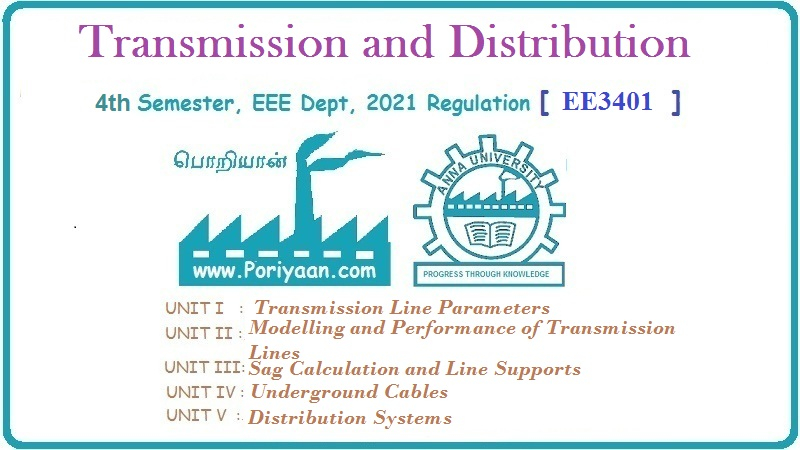Transmission and Distribution: Unit V: (a) Distribution Systems
Power Factor Improvement Devices
Static Capacitors - Synchronous Condenser - Phase Advancers
Question : 1. Explain the various power factor improvement devices.
Power Factor Improvement
Devices
For power factor improvement, special
steps are taken by using special devices. The devices generally used to improve
the power factor are
1. Bank of static capacitors
2. Synchronous condensers
3. Phase advancers.
1. Static Capacitors
The power factor of the device can be
improved by using bank of static capacitors. These capacitors are connected in
parallel with the device which is working at lagging power factor. The
capacitors draw leading current at an angle of 90° from respective voltage.
This helps in partly or completely compensating for the lagging reactive
component of load current. Due to this the overall p.f. of the system
increases. The p.f. is normally kept at or around unity so as to get p.f.
incentive from supply authorities. The capacitor method of power factor
improvement finds its applications in most of the industries.
In case of three phase circuits, the
capacitor bank connected either in star or delta is used which is shown in the
Fig. 7.21.1.

Advantages
a) As capacitors are static devices
without having any rotating parts, this method of p.f. improvement is nearly
maintenance free.
b) The losses are less in this system.
c) Installation of capacitors is easier
as they are light without requirement of any foundation.
d) The working of capacitors is not
affected considerably with ordinary atmospheric conditions.
Limitations
a) The repair of capacitors after damage
is not economical.
b) The life span of capacitors is short
ranging from 8 to 10 years.
c) With the increase in voltage from
rated value, capacitors can be easily damaged.
2. Synchronous Condenser
The over excited synchronous motor takes
a leading current and its behaviour is similar to that of a capacitor. If such
a motor is operated at no load and connected in parallel with the equipment
operating at lagging p.f. then the overall p.f. of the system improves.
Thus an over excited synchronous motor
operated on no load is known as synchronous condenser. It helps in improving
p.f. by taking leading current from supply and compensates the lagging reactive
component of load. The system and corresponding phasor diagram is shown in Fig.
7.21.2.

The three phase load is operating at low
lagging p.f. cos ϕL which is to be improved. The synchronous
condenser takes a leading current IM at an angle of ϕM from respective voltage. The
resultant supply current IS is phasor sum of IM and IL.
Current IL lags behind the voltage. As the phase angle is less than
L, cos ϕ is greater than cos ϕ and p.f. of the system improves.
If the motor is ideal without any losses
then phase angle ϕM will be 90°. But in practice even at no load
losses are present so the phase angle is less than 90°.
The synchronous condensers are
extensively used at substations for improving p.f. of the system.
Advantages
i) The excitation to the field of motor
can be varied which changes the magnitude of current drawn by motor suitably.
This helps in obtaining stepless control of power factor. The p.f. improvement
with capacitors can be done in steps by switching on the capacitors from
capacitor banks so stepless smooth control is not possible by capacitors.
ii) The removal of fault is easy.
iii) The thermal stability of the
windings to short circuit currents is high.
Limitations
i) It requires maintenance due to
rotating parts which increases cost.
ii) There are significant losses in
motor and its operation produces noise.
iii) The synchronous motors are not self
starting hence an auxiliary equipment is required.
iv) Upto rating of 500 kVA their cost is
greater than that of static capacitors.
3. Phase Advancers
The p.f. of induction motors can be
improved by phase advancers. The p.f. of induction motor is low as its stator
winding draws an exciting current which is lagging behind the supply voltage by
90°.
The stator winding can be made free from
exciting current if the exciting ampere turns are provided from other a.c.
source. The phase advancer performs this task by acting as an a.c. exciter. The
main motor and phase advancer are mounted on same shaft. The phase advancer is
connected in the rotor circuit of the motor. It helps in supplying exciting
ampere turns to the rotor circuit at slip frequency as rotor of an induction
motor runs with slip speed less than synchronous speed. Thus with excess ampere
turns supplied to the motor then required, the induction motor is operated at
leading p.f. similar to synchronous motor.
Advantages
i) The lagging kVAR taken by motor are
significantly lowered as the exciting ampere turns are provided at slip
frequency.
ii) The phase advancers can be used
where synchronous condensers cannot be used conveniently.
Limitation
The principal disadvantage of phase
advancer is that they are uneconomical for motors rated below 200 HP.
Review Question
1. Explain the various power factor improvement devices.
Transmission and Distribution: Unit V: (a) Distribution Systems : Tag: : Static Capacitors - Synchronous Condenser - Phase Advancers - Power Factor Improvement Devices
Related Topics
Related Subjects
Transmission and Distribution
EE3401 TD 4th Semester EEE Dept | 2021 Regulation | 4th Semester EEE Dept 2021 Regulation
